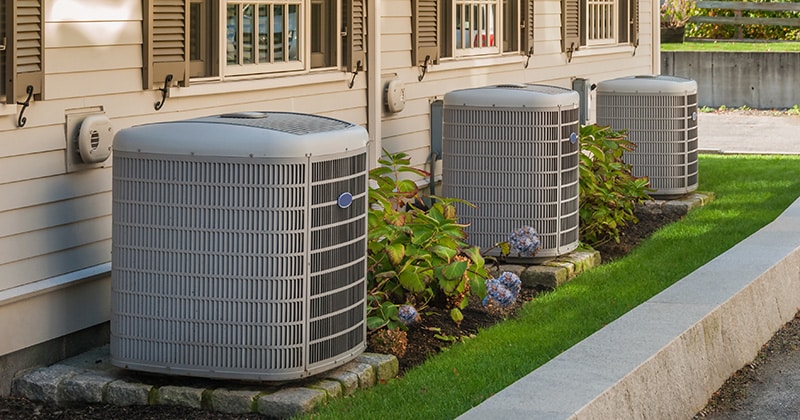
Adequate demand for HVAC services will never be a problem. People always need help with their heating and cooling systems.
What will change is who customers call when their furnace breaks down. When competitors open in your area, they might attract some of your market.
But if you manage your HVAC business efficiently, you will dominate your market no matter what. Here’s why:
Your streamlined scheduling and order processes ensure customers have a good experience. Innovative use of technology makes you efficient. Your marketing works. And wise financial management allows you to reinvest in your business. As a result, you always have the right supplies and materials on hand, and your staff is well-trained.
The key here is practical HVAC business management.
When well-managed, all aspects of your business fall into place. On the other hand, a haphazard approach causes business to fall apart.
So, what do you need to run your HVAC business like a well-oiled machine? This article covers nine key concepts to successful business management.
Efficient HVAC Service Scheduling
Efficient scheduling is essential for any home services business. It helps you make the most of your technicians’ time.
You can get more granular to generate even greater benefits. For instance, you can schedule the right technician for each job based on their skill set. You can also match technicians to customers based on service history.
All of this can help you ensure a better experience for your customers. And a better experience increases the chance that they’ll call you the next time they need help. But that’s only one piece of the puzzle.
Having a robust scheduling system can also help you:
- Track your resources
- Identify opportunities for growth
- Prioritize jobs effectively
Today, most HVAC businesses manage service scheduling with software. The market size for HVAC service management software was already close to USD 800 million in 2022. It’s expected to grow by 17.3% each year through 2028. At that point, the market will surpass USD 2 billion.
Technology is the way to go if you want to streamline your service scheduling.
You can also use these tips:
- Track your jobs and estimates. Whether you have a dashboard or a spreadsheet, you need to see where all your in-progress service calls are and what they’re worth. This will help you avoid service overlaps.
- Offer online booking. Your customers should be able to book the service they need through their laptop or mobile phone.
- Have a system for dispatching your technicians on the go. Whether you need to re-route your technicians or add a job to their day, it should be easy to communicate with your team in the field.

Effective HVAC Inventory Management
Don’t keep your customers waiting because you don’t have enough supplies. Every HVAC company should have the necessary supplies and materials to service your target audience’s HVAC systems.
Good management helps your company avoid understocking supplies. That means your technicians can complete your jobs faster. It also leads to higher customer satisfaction.
HVAC inventory management can also help your business save money. When your staff is on top of stock levels, you can order materials in bulk ahead of time and negotiate better rates with suppliers. You also avoid higher costs for rush orders or faster shipping.
Inventory management requires good organizational skills. These tips will also help:
- Set your ideal inventory baselines. Determine your ideal stock levels for service vehicles, office, and storage. Then, use either software or a spreadsheet to maintain those levels.
- Schedule routine stock audits. Check your material and supply levels regularly. Discard and replace outdated supplies so you always have quality items on hand.
- Train your team. Who should technicians communicate with when they use existing materials? What are your company’s restocking procedures? Ensure everyone on your team knows what to do to ensure inventory is always up to date.
RELATED ARTICLE: 7 Tips to Manage Your HVAC Business More Effectively
Optimized HVAC Work Order Management
Managing work orders is one of the most overlooked areas of HVAC business management. It’s also one of the most important.
In a perfect world, work orders come in. Jobs are assigned. Technicians provide service. The work order is closed.
What happens when a technician misses a notification? What if you overbook your technicians by mistake?
When you optimize your work order processes, you can prevent issues that can slow down business. Optimized work order management also leads to less frustration and happier customers.
Here are three tips to improve your work order management:
- Create a clear SOP. Make a standard operating procedure document that details processes for creating, communicating, and closing work orders. Clarify roles, responsibilities, and expectations. For instance, who checks work orders? Who decides how to prioritize them and with what parameters? How long should it take to process a work order?
- Use checklists. Develop custom checklists or templates to guide your team. This will ensure everyone follows the correct steps. It also makes training and onboarding faster for new staff.
- Streamline work order management with technology. Software can handle prioritization for work orders. It also reduces errors and speeds up the process.
FROM ONE OF OUR PARTNERS: HVAC Pricing Guide: How to Price HVAC Jobs
Strategic HVAC Technology Integration
Technology streamlines processes. It automates routine tasks. And it helps your team work together better. All of this leads to lower costs and greater productivity.
However, how you manage your technology integration determines how much you’ll benefit.
To be strategic about technology, here’s what you can do:
- Implement the right tools. For an HVAC business, high-value tools include field service management, customer management, and a system for managing estimates, invoices, and payments.
- Make sure your software integrates easily. Your systems should integrate with your business tools, such as your accounting software or collaboration tools.
- Simplify where possible. There are dozens of tools your HVAC business could benefit from. That doesn’t mean you should build a large tech stack. Juggling multiple apps leads to wasted time switching between tools, siloed data, and more significant security vulnerabilities. Using a single tool covers most of your needs and simplifies your technology.
FROM ONE OF OUR PARTNERS: How to Create an HVAC Business Plan

Skilled HVAC Workforce Management
Your technicians are your most valuable resource. So, how you manage them will impact your bottom line.
Workforce management leads to less turnover and a better work culture. It can also give your business a competitive advantage. The reality is there’s a shortage of skilled HVAC techs right now. In 2023, the industry was short by 110,000 HVAC technicians, with 25,000 leaving the company each year.
Excelling in workforce management also leads to better service. With a highly skilled workforce, your company can take on more complex jobs. This opens the door to higher revenue, more growth, and an ironclad reputation.
Implement these strategies to manage your team better:
- Start with skilled talent. Take a look at your hiring practices. Are you vetting candidates properly? In addition to standard background checks, consider hiring for culture fit and experience.
- Create a mentor program. Pair new hires with more experienced technicians. This can help new hires learn faster. It also builds relationships.
- Equip your team with technology. Not having the right tools and processes leads to frustration, wasted time, and poor service quality.
- Implement tools for streamlining workflows. That way, your HVAC technicians can spend less time dealing with work problems and more time focusing on what they do best — servicing heating, cooling, and ventilation systems.
Effective HVAC Marketing and Customer Acquisition
Marketing lets potential customers know your business exists. It’s ground zero for acquiring new customers. It’s also through your marketing — as well as service quality — that you keep customers coming back.
Managing your marketing effectively can help your HVAC company stand out. When someone is looking for help with a broken AC unit or wants to install a new system, chances are they’ll begin searching for a provider online.
What’s interesting is a lot of your potential customers might not have a brand in mind when they type “AC repair near me” into Google. One study found that, for HVAC repair, 84% of consumers do not have a specific company in mind when beginning their search.
This gives HVAC companies of all sizes a massive opportunity. You can acquire customers through a well-developed online presence. That might include the following:
- A website to provide information on your services, your company, and booking
- SEO to make your site show up on search engine results pages
- Content to attract searchers using relevant keywords
- Social media to appeal to potential customers who use social sites to read reviews and learn about brands
However, creating content and managing campaigns can be time-consuming. And if you outsource to a marketing agency, it can be expensive. So, how can you ensure your marketing is working for your business?
- Use data to inform your strategy. Tools like Google Analytics and SEMrush can help you track your marketing performance and identify opportunities.
- Document your strategy. One mistake small businesses make with marketing is they invest time, energy, and money into different channels without thinking about how everything works together. That’s why creating a holistic strategy and writing it down is essential. Establish what channels you’ll use, your budget, goals, timelines, and roles and responsibilities.
- Bring on marketing expertise. Either hire people to handle your marketing or outsource to experts. You’ll get a better return on your investment when you have experienced professionals in charge of marketing. You’ll also free up you and the rest of your staff to focus on running your business and providing excellent HVAC services.
FROM ONE OF OUR PARTNERS: Use These Big Marketing Ideas to Attract Customers to Your Small Business

Maximized HVAC Customer Retention
Getting people to book HVAC service brings in new customers. However, you also should encourage repeat business to support growth.
It’s well known that it costs less money to retain existing customers. These people are already familiar with your brand. They may even be brand advocates — people who publish positive reviews online and share their experiences with others.
So, how can you capitalize on the value of your existing customers and increase retention?
Try these three tips for maximizing customer retention:
- Create a loyalty program or offer promotions to repeat customers. For instance, you can give customers who hired your HVAC company for installation services a discount for annual maintenance.
- Hand out business cards. There’s no question that digital marketing reigns supreme. But that doesn’t mean traditional promotional tools like business cards are obsolete.
- For a home services business, calling cards are still useful. Make sure your technicians give every customer a card during service calls. That way, when your customer needs HVAC services down the line, they already have your contact information on hand.
- Provide exceptional service. The best way to encourage repeat business is to impress your customers the first time around. Managing the other aspects of your business — workforce management, inventory, service scheduling — will ensure your customers have a good experience.
However, it’s also worth training your techs so they have excellent customer service skills. A friendly, knowledgeable technician will create a good impression. That will make your customers more likely to consider you their go-to for future HVAC needs.
RELATED ARTICLE: 6 Ways to Improve HVAC Customer Retention and Boost ROI
Successful Financial Management
Managing your business finances will help your company weather slow periods. It also enables you to make better use of profitable periods. When you manage money well, you can:
- Reinvest in your business
- Use debt for growth rather than catching up
- Avoid cash flow challenges and the problems that come with them
What does successful financial management look like for an HVAC business?
You should have a financial plan. Document your goals over time. For example, create goals for each quarter, year, and three-year period.
Have targets for metrics like your profit margin, debt-to-equity ratio, and revenue growth. Doing this will help you stay focused on creating financial health amidst all the other tasks involved in HVAC business management.
Working with a budget is also critical. To simplify budgeting, use software to keep track of expenses, monitor changes, and ensure your budgets are accurate.
And finally, learn the accounting basics. You’re busy. You might not have a financial or accounting background if your expertise is in heating and cooling systems. However, it’s worth it to take the time to learn the basics.
Know what financial documents you need for planning, taxes, and budgeting. These are the income statement, the balance statement, and the cash flow statement. Also, learn how to calculate profit and determine how much your business needs to sell to be profitable.
Accounting software and other financial technology, like budgeting and expense management, are still your best friend. But you’ll be able to make wiser decisions when you have a basic understanding of business accounting.
FROM ONE OF OUR PARTNERS: The Ultimate Guide to Small Business Financial Management
Optimized HVAC Compliance and Safety
The final piece of the puzzle is compliance and safety. Staying on top of safety and compliance creates a better work environment. It also helps your company avoid legal trouble and fines.
Optimize compliance and safety with these three tactics:
In the home services industry, the risk of injury at work is high. You can offer safety training to your technicians to minimize the risk of injury on the job.
You must also ensure your technicians have the appropriate licenses and certifications for the industry.
Today, you’ll also need to factor in digital compliance and safety. Make sure the systems you use are secure. Your provider should follow all current regulations and keep the software up to date to avoid security vulnerabilities.
Get Started with HVAC Business Management Now
Better management paves the way for more business, happier customers, and growth. There’s a lot to handle. You need to be organized and goal-focused. You also need the right tools and talent to support you. However, now that you know what core aspects of business management to focus on, you can roll up your sleeves and get started.
Here are three steps you can take now to get the ball rolling.
- Create a spreadsheet. Make a simple spreadsheet with these nine core business management areas. Write down three things you’ll do this week for each area.
- Brainstorm with your team. Talk to your management team to see if they see any opportunities for improvement that you’ve missed. What core areas of your business do they believe need the most focus? Which ones do they think are already well managed?
- Decide what software you need. Technology will serve as your control panel for every area of business management. Do an audit of your current software. Are there tools you don’t have? Are your current systems equipped to help you better manage your business? Identify where you have gaps in your tech stack so you can start strong as you transform your business with better management.
Related Posts
Stay Informed
Get the latest news and insights plus, Service Fusion offers and updates.Thank you for your submission.
SHARE